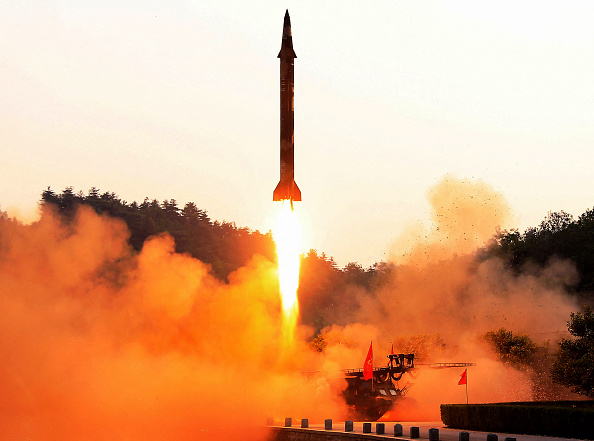US Navy's Anti-Hypersonic Missile Energy Systems Now Being Developed; Efficient Against Chinese, Russian Rockets?
Here are a portion of the coordinated energy frameworks being tried.
The U.S. Naval force is currently making against hypersonic rocket guided energy frameworks among its needs to improve the country's protections.
(Photograph : Photo by STR/KCNA through KNS/AF)
This undated photograph delivered by North Korea's true Korean Central News Agency (KCNA) on May 30, 2017 shows a test-fire of a long range rocket at an undisclosed area in North Korea.
The protection office's top chief of naval operations, Adm. Michael Gilday, affirmed this arrangement on Thursday, Aug. 25.
The Chief of Naval Operations said they are currently dealing with cutting edge coordinated energy weapons that can obliterate quick rockets sent by Russia and China.
For those new to coordinated energy frameworks, Lockheed Martin made sense of that these protection specialists go about as strategic advantages, permitting warfighters to counter rocket dangers.
US Navy's Anti-Hypersonic Missile Energy Systems
As indicated by CNN Politics' most recent report, coordinated energy frameworks utilize extreme laser power or strong microwaves to dispense with hypersonic rockets.
(Photograph : Photo by EMMANUEL DUNAND/AFP through Getty Images)
An Israeli armed force engineer assesses the "Light Blade" laser guard framework, intended to capture airborne combustible dangers sent off from the Gaza Strip, in the Israeli kibbutz of Kissufum, along the boundary with the Palestinian area on August 30, 2020.
As of press time, rockets that can travel multiple times the speed of sound actually inconvenience the United States' guarded innovations.
Beside being excessively quick, hypersonic rockets additionally have erratic directions, making them more risky contrasted with ballistic rockets and different models.
"They're a huge concern. Russia and China are both fostering those abilities and will handle those capacities not long from now," said Gilday.
Presently, when the required coordinated energy weapons are finished, the U.S. Naval force is supposed to have more productive countermeasures against the hypersonic rockets of Russia and China.
US Navy Tests Laser Weapons
The U.S. Naval force has previously tried coordinated energy frameworks that depend on high-thickness lasers. Be that as it may, some fizzled or were simply evolved to annihilate little dangers.
In 2014, a laser weapon framework was utilized on the USS Ponce. The protection tech had the option to bring down little airplane, robots, and, surprisingly, little boats.
The U.S. Naval force additionally tried the Air-sent off Rapid Response Weapon (ARRW). Be that as it may, this laser tech flopped multiple times before it succeeded last April.
Presently, the safeguard organization chose to introduce the HELIOS laser framework created by Lockheed Martin. This energy-put together weapon was mounted with respect to the USS Preble, putting forth it the most recent safeguard attempt made by the Navy.
In different stories, the U.S. Military blamed Russia's satellite Kosmos 2558 for shadowing its covert agent satellites.
Then again, Lockheed Martin's layered laser weapon, which can shield fighters from monstrous dangers, was recently tried.
For more news refreshes about the U.S. Naval force's forthcoming coordinated energy frameworks and other safeguard specialists, consistently keep your tabs open here at TechTimes.
This article is claimed by ZOHAANTECHMASTER
Composed by: ZOHAAN.CH
Tags
Technology


.jpg)